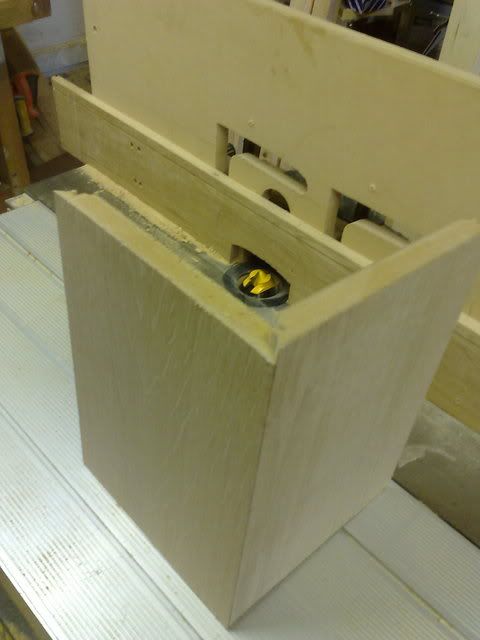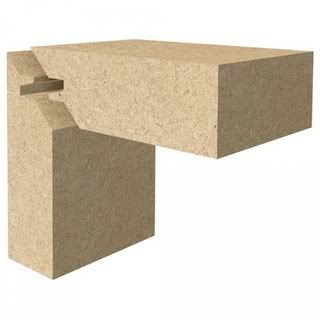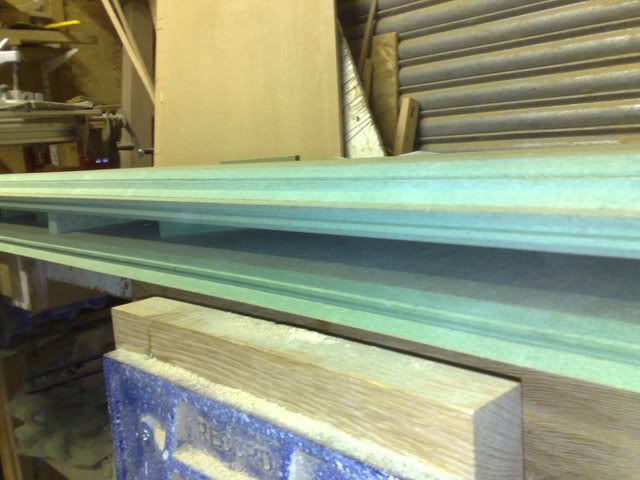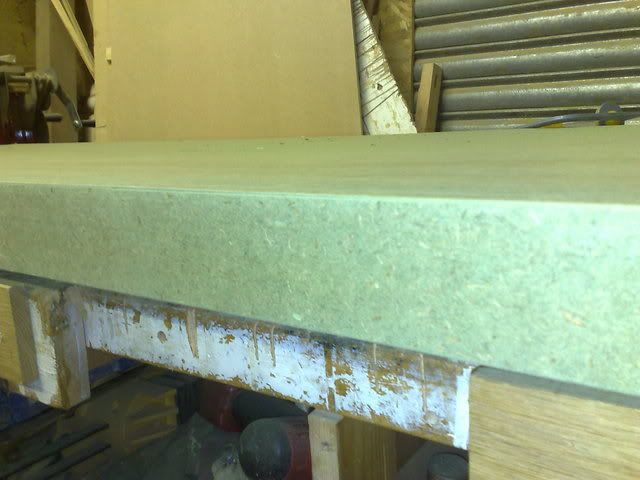|
|
Post by jfc on Dec 1, 2007 9:19:29 GMT
Has anyone used the mitre lock router bit to join boards along a 2.4 m edge ? Did it just slot together or was it a nightmare ?
|
|
ring
New Member

Posts: 2
|
Post by ring on Dec 1, 2007 9:46:09 GMT
it was a nightmare to set up ,dont know how many scraps of wood i ran until i got the right set up.
Jim
|
|
|
|
Post by jfc on Dec 1, 2007 10:56:34 GMT
OOOOOO i like this ;D  I managed to set it up quite quickly  mind you it goes like that sometimes . I can see it needing an infeed and outfeed table to do a 2.4m joint . |
|
|
|
Post by Scrit on Dec 1, 2007 11:32:53 GMT
Jason I'd agree with Jim that many of these cutter sets  are murder to set-up on either the router or spindle moulder simply because they involve running a long board vertically on a sharp edge which can result in the material dropping on the outfeed side of the cutter and is extremely difficult to keep upright, particularly on long and heavy pieces, whilst short pieces such as drawer sides can present equally difficult challenges as to struggle to keep them exactly vertical on a short edge which is always threatening to "submarine" into the table opening. For this reason I've tried and now avoid them as the same effect can be had by simply working a mitre on each edge to be joined then either angle biscuiting or working a groove in the face of the mitre which can be usd to strengthen the joint by the simple addition of a loose tongue glued in. The mitre can be worked flat meaning that it is potentially much easier to work a joint:  Incidentally, I feel that this is one area where an EZ, Festool, Bosch, etc tool rail in conjunction with a router and chamfer bit can yield positive advantages in working the joint over all but the largest saws and/or spindle moulders simply because the workpiece can be more readily supported If a small amount of end grain is permissible then a simpler joint to work might be a straightforward lock joint, thus:  as this can be worked with a variety of straight cutters. So my feeling is that unless your material is narrow and can be adequately supported at both infeed and out feed ends that the joint isn't really susch a practical proposition Scrit |
|
|
|
Post by engineerone on Dec 1, 2007 13:05:02 GMT
at the risk of starting a whole nother debate,  seems to me that this would be a good case for making your router at least work in the horizontal mode, so that the wood is flat on a table. unless of course i have totally mis understood how the cutters work  also i guess one occasion where a wood rat would be a better tool than a spindle moulder ;D paul  |
|
|
|
Post by Scrit on Dec 1, 2007 13:27:36 GMT
I can't see that having the router horizontal would make any difference, Paul. One side of the joint would still need to be machined horizontally and the other side vertically One thing I would do is once the cut set-up is correct make-up a horizontally-cut setting block in hardwood of the same thickness as the material you've made the joint from. That way next time a lock mitre joint is cut the cutter can be set almost correct very quickly and with minimal tweaking required. also i guess one occasion where a wood rat would be a better tool than a spindle moulder ;D You've obviously got the pre-production 8ft long model  . Wonder what it will cost ;D Incidentally, Jason, why on a router table? Job not good enough for the spindle? Scrit |
|
|
|
Post by nickw on Dec 1, 2007 14:02:44 GMT
If I'm using this type of cutter, I try to arrange things so that the resulting edge will be chamfered/radiused/moulded in some way after assembly. This means that you can leave a small square edge (say 1-2mm) to run against the fence while the joint is being cut - or a large one if a large chamfer/radius/moulding is used.
Of course it does then need a little extra maths to get the widths of the boards right. ;D
To get the height setting of the cutter right, run two boards flat on the table through the cutter, then put them together, one the right way up, the other upside down. The resulting step between the two surfaces will be twice the adjustment that you need to make to the height of the cutter.
Next set the fence position. I use a sacrifical fence with this cutter. Mark on the fence the thickness of your boards, measured from the table. Then move the fence into the running cutter until the top of the cut it makes in the fence just touches your line. Bingo.
If you are leaving a square edge offset the marked line on the fence downward by the desired edge width.
I hope this makes sense.
|
|
|
|
Post by jfc on Dec 1, 2007 14:17:16 GMT
Im using it on the router table because the cutter is for a router . I couldnt find it off the peg for the spindle .
|
|
|
|
Post by Scrit on Dec 1, 2007 14:51:02 GMT
Nick Interesting technique and definitely one to remember ;D Im using it on the router table because the cutter is for a router . I couldnt find it off the peg for the spindle . Take a look at this, then, Jason. Can't find any reference for cutters for use in a Euro block, however  Scrit |
|
|
|
Post by engineerone on Dec 1, 2007 15:18:34 GMT
ok, scrit, i thought you could figure it out. you are right, you need two routerrs, one vertical and the other horizontal, surely then the horizontal router would cut that part of the jooint that would be vertical on the router table. paul  |
|
|
|
Post by jfc on Dec 1, 2007 15:44:59 GMT
The reason i want to use the mitre lock is to get rid of the joint when making a bulky shelf that always shows . I think it's worked quite well .  This is the worst bit just for Dom ;D  |
|
pewe
New Member

Posts: 49
|
Post by pewe on Dec 1, 2007 15:46:33 GMT
Glad you said that and not me.  If it is a very long run you would need a long guide rail. There is another way to do it however. Clamp the board edge up on the side of a long table (length to match the material plus a few inches either end) with the top edge of the material flush with the top of the table. Make up a block of some kind with holes drilled to take the router bars so that the block sits flush on the table top when the router is sat on the table. Now screw down a a runner on the table top parallel to the edge, then screw another one down so that the gap between the two forms a 'slot' for the block to run in. Providing the material used for the block and the runners is of a material that does not cause sticking you can set the router bit to the correct position for cutting using the router bars and the depth stop. Now you can cut without fear of the router moving side to side and spoiling the joint. If you do a lot of this type of joint, you can route grooves in the table top so the runners can be dropped in and screwed in place when needed, and removed when not required to free up the table top again. That's the method I used for cutting a few of these joints before I got my rail system (which does make the job a lot easier). As already mentioned, another solution is to use a horizontal router, but making one is quite time consuming and buying one is quite expensive - but still worth it if you do a lot of this type of routing. |
|
|
|
Post by jfc on Dec 1, 2007 15:51:50 GMT
Or you could just run it past the cutter in the router table  ;D |
|
pewe
New Member

Posts: 49
|
Post by pewe on Dec 1, 2007 16:11:18 GMT
Yes, I agree, for smaller sized panels, - or if you have a solid way of supporting a long, wide panel perfectly and constantly upright on the table as you pass the cutter, and also have clear space and support at least the length of the board on both the infeed and outfeed side of the table  Depends on the panel size really. The job I was doing was 2500mm long and the panels were 600 and 300 wide, I just found it easier to have the router moving rather than struggle with the boards  |
|
|
|
Post by jfc on Dec 1, 2007 16:38:25 GMT
These where 2400 mm x 500 mm the face was 60mm . the weight of the boards held themselves flat on the router table but i did use two hold downs . the 60mm part was done on edge and just held in place with my hands . As you can see not a perfect joint but i think it's going to be better than just a butt joint where the paint cracks over time .
I do agree if you are tight for space then having the router moving may be better but if you struggle with half a sheet of MDF your in the wrong game ;D seriously i did think of using the clamp and guide for this but there is a tiny bit of play when the router is on the track so that would have been no good for this plus i'm not sure i would have done it in one pass with the router hand held .
|
|
|
|
Post by dom on Dec 1, 2007 17:41:34 GMT
Or run a handheld with a bit that large in it   Glad to see it turned out well jason. |
|
|
|
Post by jfc on Dec 1, 2007 18:44:31 GMT
You do know they sell them with a 1/2" shank dont you Dom ;D
|
|
|
|
Post by jfc on Dec 1, 2007 22:36:16 GMT
I dont want to do it as a shadow gap as it is the face of the book case . Dont get me wrong i hide the cheats but just not on the face .
|
|
|
|
Post by dom on Dec 3, 2007 19:47:45 GMT
You do know they sell them with a 1/2" shank dont you Dom ;D Yup. For the benefit of those who have never seen one, here are two which cover timber or mdf from 12- 22mm  If you wanna hold the router with that one on the right spinning round I'm gonna tell Scrit ;D |
|
pj
Junior Member
 
Posts: 88 
|
Post by pj on Dec 3, 2007 20:50:57 GMT
Looks like it turned out pretty well Jason. The longest boards I have used with these bits is about 4ft in both oak and birch ply, although the oak turned out better. I did as Nick does and left about 1mm land and then used a 1/8 roundover on the nose. I have to say that while it was a pain to set up gluing up was somewhat less fraught. I have vivid memories of the last time using the 70mm dia bit, the router speed controller decided to go t*ts up and preceded to accelerate to about 20000 rpm in mid cut.  Philip |
|
|
|
Post by dom on Dec 3, 2007 20:53:46 GMT
|
|
|
|
Post by jfc on Dec 3, 2007 21:10:45 GMT
I shoved another couple of panels through today and made an even worse cut but still easy to glue up and a better job than leaving end grain . I'll be using this for most of my work of this kind in the future .
|
|
|
|
Post by Scrit on Dec 3, 2007 22:59:58 GMT
If you wanna hold the router with that one on the right spinning round I'm gonna tell Scrit ;D Don't bother - I can't stand the sound of screaming or the sight of blood!  |
|
|
|
Post by stehleuk on Jan 10, 2008 15:41:09 GMT
www.cutting-solutions.co.uk/6.html The web site is still under construction so it doesnt look too good at the moment As a newby here and a dumb head when it comes to confuser things i hope it works.
|
|
|
|
Post by 9fingers on Jan 10, 2008 17:30:04 GMT
www.cutting-solutions.co.uk/6.html The web site is still under construction so it doesnt look too good at the moment As a newby here and a dumb head when it comes to confuser things i hope it works. Please can you explain what this HPS blade material is. I've not come across it in other forms of engineering where carbon steel, high speed steel, and tungsten carbide are the usual offerings for cutters. TIA Bob |
|